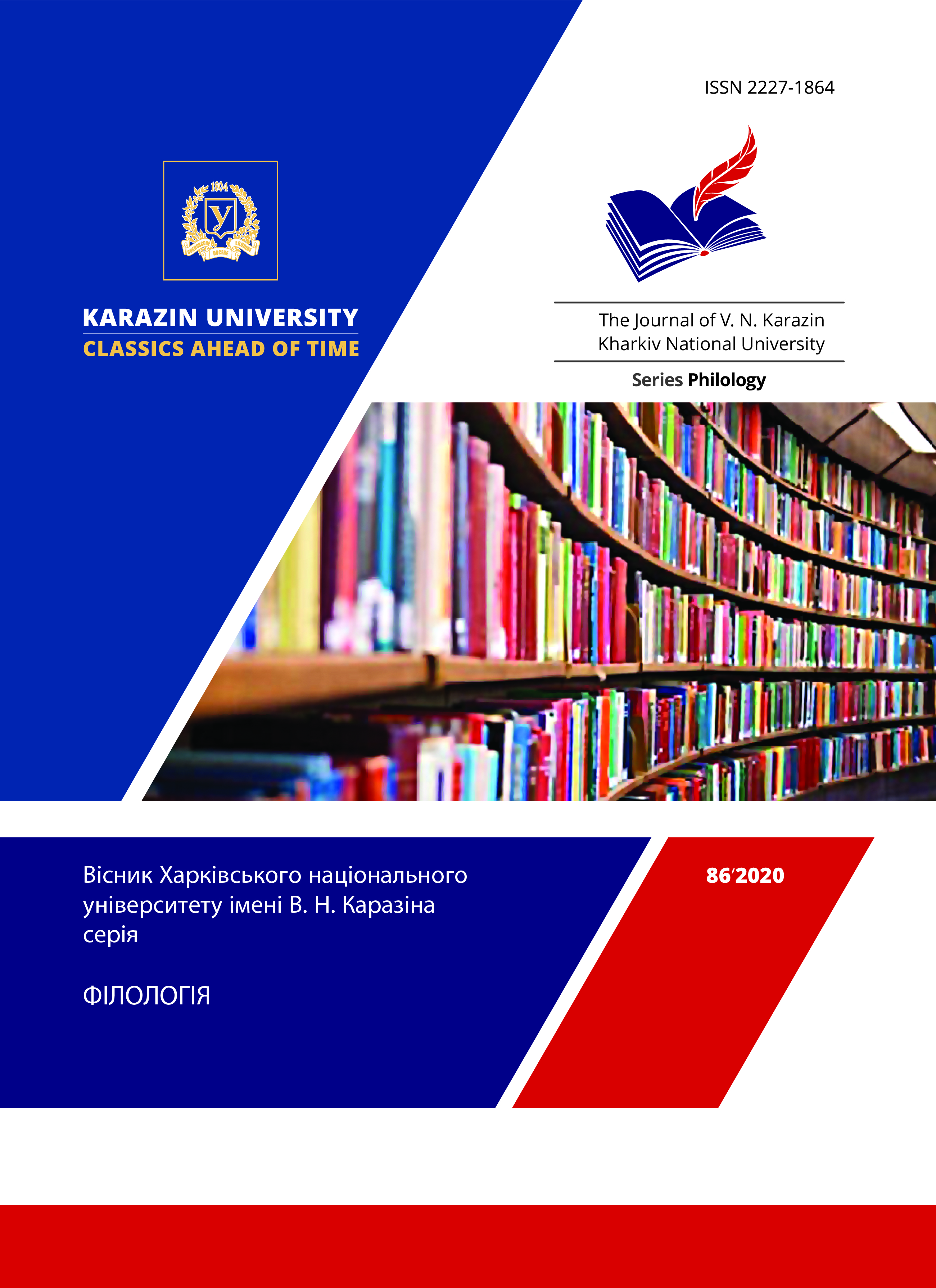Fate: Folklore representations and artistic interpretation by Ukrainian writers of the second half of the XIX – early XX century
Abstract
The paper presents the analysis of the peculiarities of the artistic interpretation of the concept of «fate» – one of the key in people’s consciousness. Materials for research were selected works of Ukrainian artists of the second half of the XIX – early XX century, which, in the opinion of the author of the paper, are one of the most representative in the transformation of folk ideas about fate.
The degree of similarity of the concepts of the synonymous nest «fate» is determined, the opinion of researchers about the fate is commented upon in view of the coexistence in this concept of the idea of certainty, integrity, case.
The artistic material was analysed taking into account the degree of author’s rethinking of the key concept: personification/abstraction, semantic basis, aesthetics, emotionality, methods of text input, poetic means. Among the priority forms are the mirror, oxymoronity, gradation, contrast.
A separate aspect of the study is changes in the characters, their behavioural models, which made it possible to conclude about the specifics of the interaction of the individual and general (first of all, mental, national) principles – fundamental to understanding of the process of extrapolation of folk ideas about the fate according to their author’s decisions.
It is proved that the cognitive connection between the analysed works is carried out by means of cantering the notion of «fate» in a text space with different emotional features, which made it possible to generalize the peculiarities of its presentation in works in which the non-creative and environment is presented.
In general, the paper the thesis that the proposed method of studying of artistic material – from archetype to individual author’s model – will contribute to a more complete, deeper tracking of the stages nature of the formation of cultural vertical.
Downloads
References
Bondaruk, L. (2019). Polifunkcionalnist symvolu: z teorij pohliadiv // Filologchni nauky.Vyp. 30. S. 50–52.
Bulashev, H. (1992). Ukrainskyi narod u svoikh lehendakh, relihiinykh pohliadakh ta viruvanniakh. Kosmohonichni ukrainski narodni pohliady ta viruvannia. Kyiv: Dovira. 141 s.
Vertiy, O. (2014). Pytannia estetyky ta poetyky usnoij narodnoij tvorchosti u folklorystychnij spadschyni Ivana Franka // Literatury svitu: poetyka, mentalnist i dychovnist: zbirnyk naukovych pratc / hol. red. A. Kozlov. Kryvyj Rih. Vyp. 3. S. 51–66.
Veselovskiy, A. (1891). Neskolko novyih dannyih k narodnyim predstavleniyam o Dole // Etnograficheskoe obozrenie / pod. red. N. Yanchuka. Moskva. № 2 (god 3), kn. IX. S. 20–29.
Vovchok, M. (1983). Try doli // Opovidannia, kazky, povisti, roman / uporiadkuv. i prymit O. Biliavskoi, vst. st. N. Krutikovoi, red. tomu N. Krutikova. Kyiv: Nauk. Dumka. S. 294–367. (Biblioteka ukrainskoi literatury).
Voitovych, V. (2002). Ukrainska mifolohiia. Kyiv: Lybid. 664 s.
Hnatiuk, V. (2000). Narys ukrainskoi mifolohii/pidhot. ta oprats. tekstu, vst. st. i prymit. R. Kyrchiva, vidp. za vyp. S. Pavliuk, red. M. Horban. Lviv: Instytut narodoznavstva NANU. 263 s.
Hoholina, V. (2016). Intertextyalnist, intertext, intext:interpretacijni pidhody // Spheres of Culture / ed. I. Nabytovych. V. XIV. S. 24–35.
Zhaivoronok, V. (2006). Znaky ukrainskoi etnokultury: slovnyk-dovidnyk. Kyiv: Dovira. 703 s.
Ivanov, P. (1991). Narodnyie rasskazyi o Dole // Ukrayintsi: narodni viruvannya, poviriya, demonologiya/uporryadkuv., prymit. ta biogr. narysy A. Ponomarova, T. Kosminoyi, O. Boryak; vst. st. A Ponomarova. Kyiv: Lybid. S. 342–375.
Karpinskyi, K. (2016). Razvitie smysla zhizni v ontoheneze: osnovnyie psicholohicheskie zakonomernosti // Vestnik Hrodnenskoho hosydarstvennoho universiteta imeni Yanki Kupala. Seria 3. T. 6, № 1. S. 113–122.
Kostomarov, N. (1994). Neskolko slov o slavyano-russkoy mifologii v yazyicheskom periode, preimuschestvenno v svyazi s narodnoy poezieyu // Sloviyanska mifologiya / uporyad., prymit. I. Betko, A. Polotay; vst. st. M. Yatsenka. Kyiv: Lybid. S. 201–257.
Nechui-Levytskyi, I. (1992). Svitohliad ukrainskoho narodu. Eskiz ukrainskoi mifolohii. Kyiv: Oberehy. 86 s.
Potebnya, A. (1914). O dole i srodnyih s neyu suschestvah // O nekotoryih simvolah v slavyanskoy narodnoy poezii. O svyazi nekotoryih predstavleniy v yazyike. O kupalskih ognyah i srodnyih s nimi predstavleniyah. O dole i srodnyih s neyu suschestvah. Kharkov: Tipografiya «Mirnyi tryd». S. 189–242.
Starytskyi, M. (1987). Talan // Poetychni tvory. Dramatychni tvory/uporiadkuv. i prymit. M. Maksimenko, vst. st. S. Zubkova, red. tomu S. Zubkov. Kyiv: Naukova dumka. S. 263–335. (Biblioteka ukrainskoi literatury).
Tkachuk, M. (2016). Hudoznyi svit tvoriv Ivana Franka. Ternopil: Aston. 130 s.
Tobilevych, I. (1989). Beztalanna // Karpenko-Karyi I. Dramatychni tvory / vst. st., uporiadkuv. i prymit. R. Pylypchuka, red. tomu S. Zubkov. Kyiv: Naukova dumka. S. 194–240. (Biblioteka ukrainskoi literatury).
Ukrainka, L. (1987). Lisova pisnia // Tvory: v dvokh tomakh. Kyiv: Naukova dumka. T. 2: Dramatychni tvory / uporiadkuv. i prymit. N. Vyshnevskoi, red. tomu I. Dzeverin. S. 343–431/ (Biblioteka ukrainskoi literatury).
Franko, I. (1941). Ukradene shchastia. Drama z silskoho zhynnia v piaty diiakh // Dramatychni tvory. Kyiv: Mystetstvo. S. 21–89.




